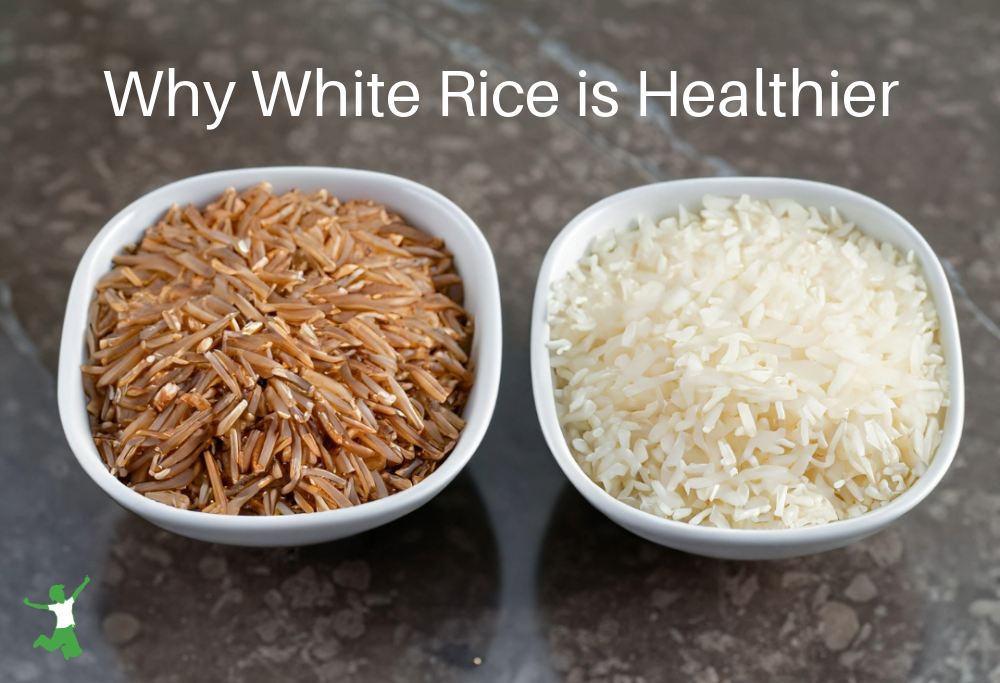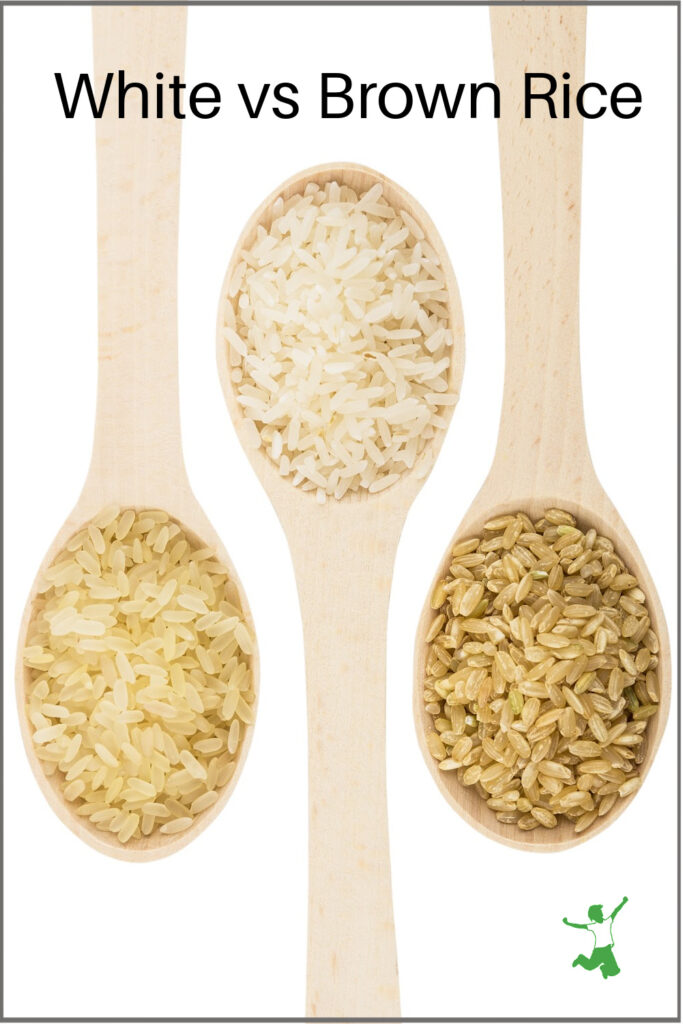The reasons white rice is healthier than brown rice as determined by research as well as which type traditional societies preferred consuming.

My article and video on healthy Chinese food drew some comments from readers who questioned my choice of rice.
Why was I using white rice vs brown? Isn’t brown rice the healthier choice, after all?
Ok, I’ll spill the beans, rice. Here are my reasons …
The truth is, neither my husband nor myself have ever enjoyed brown rice (although we love the nutty flavor and digestibility of wild rice).
Every time we eat brown, it just seems to not sit very well in our stomachs.
Even when it is sprouted or soaked before cooking, it, well, uh, sits like a brick for lack of a better word.
Why Some People Should Eat White Rice
White rice just seems to digest a whole lot better for us. That to me was reason enough to choose it over the brown rice.
We were also advised by an Ayurvedic MD back in the 1990s to stick with white basmati rice. This recommendation clinched the decision.
You are what you digest, after all – not necessarily what you eat!
End of story? Well, not quite.
Rice Fiber in Brown Harms a Compromised Gut
A few years back at the annual Wise Traditions Conference, I became familiar with a compelling book called Fiber Menace.
The author writes extensively about the dangers of a high-fiber diet as it pertains to a menu loaded with whole grains as pushed by the misguided Food Pyramid.
In other words, folks who eat a bowl of All Bran every morning to keep the bathroom visits regular are unknowingly ripping their insides to shreds.
The basic premise of Fiber Menace is that grain fiber plays a leading role in many gut-related ailments including colon cancer.
When I first learned of this information, my preference for white rice over brown rice started to make more sense.
Perhaps the brown rice didn’t digest that well because of all that fiber?
Chalk one up for the white rice.
White Rice Far Lower in Phytic Acid
A second piece of information came from author Ramiel Nagel.
In his book, Cure Tooth Decay, he writes about the devastating effects of phytic acid in the diet. Phytic acid is a very powerful antinutrient and blocker of mineral absorption in the gut.
Mr. Nagel identifies brown rice as very high in phytic acid.
What’s more, soaking brown rice does not reduce phytic acid by much at all!
Polished Rice is the Ancestral Form
Ramiel also maintains that the traditional method for preparing brown rice is never to eat it whole (with only the husk removed).
Rather, ancestral societies pounded brown rice in a mortar and pestle to polish it by removing the outer bran layer. This is the primary source of the phytic acid.
Nagel goes on to point out that experiments have shown that the milled and polished rice that results from this pounding process, has the highest mineral absorption.
In short, mineral absorption from whole brown rice is much less than white polished rice. This is because the phytic acid in the bran which is not reduced much by soaking, greatly interferes with the absorption process.
What About Arsenic?
A big issue with arsenic contamination in rice has emerged in recent years. Some folks have responded by no longer eating rice at all.
This is an overreaction, in my view.
Clean rice is definitely available if you know what to look for.
This article on how to avoid arsenic in rice details what to do. While soaking brown rice barely moves the needle on phytic acid, soaking white rice before cooking removes nearly all the arsenic!
Another option is to parboil white rice before using fresh water for a full cook if you don’t have time to soak.
Is White Rice Better Than Brown?
So it seems that brown rice is not necessarily a healthier choice than milled white rice.
Black or red rice would fall into the same category.
Obviously, whether you choose one or the other is a personal preference, but I hope this information helps you sort through the decision with a bit more clarity.
As for me and my family, we will be sticking with white basmati and jasmine rice (white basmati rice is more nutritious than plain white rice).
I currently buy this brand of rice in 25-pound bags as the most economical and high-quality choice.
Observation clued me in many years ago that brown rice was not something that was sitting well in my stomach or my husband’s.
As the years go by, more research is coming forth to indicate that this decision was the right way to go after all.
Do you eat white rice or brown rice in your home? Why or why not?

References
(1) Fiber Menace
(2) Living with Phytic Acid
More Information
Macrobiotic Diet and Extreme Vitamin D Deficiency
Tiny Teff Grains Deliver Big on Nutrition
How to Make Perfect Yellow Rice (Arroz Amarillo)
Millet: Healthy or Not?
Do Whole Grains Cause Cavities?







The glycemic load of a cup of cooked brown and white rices is practically identical (21:23). If the fiber were making a significant difference in glucose absorption, there might be something to consider there, but it really doesn’t. Plus the fatty acids are primarily inflammatory O6s and they go rancid quickly, so I think white is the way to go if you tolerate the higher carb intake.
Is Hom Mali Jasmine rice any healthier than Basmati rice?
Wanting to make tomatoe sauce from “real” – well, at least not canned tomatoes, I “stumbled” onto your web page, and lbegan exploring. Thjough I have not given up bread – I’ve known for years I should, I’ve been choosing brown rice and brown rice pasta thinking they were the best. After reading this, I know why my husband doesn’t like brown ricel. He prefers minute rice the best, but thay’s another story, hee, hee.
Thank yiou so much for your detailed info! Surely knowledge can set one free! I will be visiting you lots!
Great weblog right here! Additionally your web site lots up fast! What host are you using? Can I am getting your affiliate link for your host? I want my website loaded up as quickly as yours lol
How about Hom Mali white rice, is is an healthy alternative to Basmati white rice?
I always eat white rice. I simply do not like the taste of brown rice. I never gain weight from white rice and it keeps me full just fine.
I have gained weight in the past. But it was NEVER, ever due to white rice. That much I know.
The chinese have never eaten brown rice. if you don’t believe me check it in a chinese restaurant. Brown rice has more nutrients but cannot be digested well and the body employs a lot of energy to try to get the energy out of it. in the end you end up with less energy that if you have eaten white rice. if you keep on eating brown rice you’re going to debilitate your body. True be said!
I have been diagnosed celiac since 2010 but just this month I had added gluten free corn tostitos, rolled oats and brown rice flour to my diet…only to discover I got ILL and it was the lectins.. My research says all these must go… along with quinoa, greek yogurt, bell peppers and white potatoes…. but that WHITE RICE is OK. Well thank goodness for that so I will now slowly add white rice to my diet and see how I do. So, it will be WHITE RICE at my house !
I liked your article. It’s true, every body tolerates things differently and it’s all in the gut !
I eat white rice too but I’ve just read that there is GM rice?! Engineered rice that has human genes?! Please someone tell me if it’s real! I’ve made a mistake of not buying organic rice and have been eating this white medium grain rice (I got it from an Asian grocery store) and I’m really freaked out by this…So should I switch to organic rice ASAP?!
wheat is toxic. don’t eat it. the reason whole wheat is better is because you cant digest as much of it. they extended this to rice for no reason. look what 3 billion skinny chinese people eat, white rice every meal. dont eat wheat and corn.
You need to educate yourself, because a ton of those Chinese people live on wheat, not rice. Northerners especially.